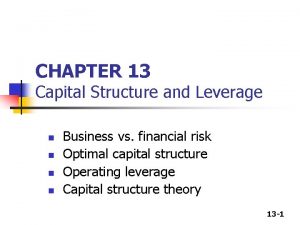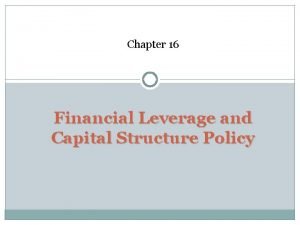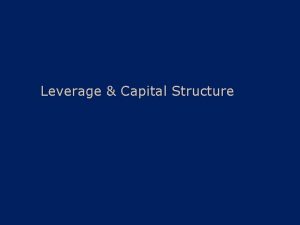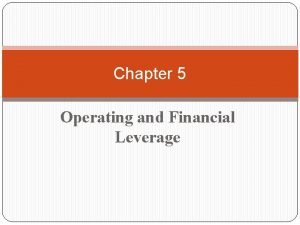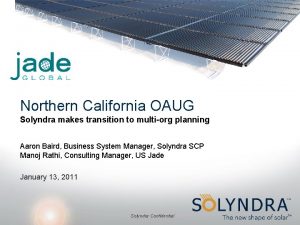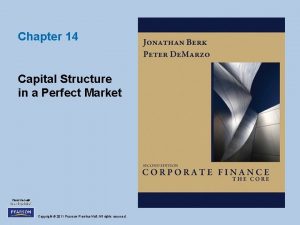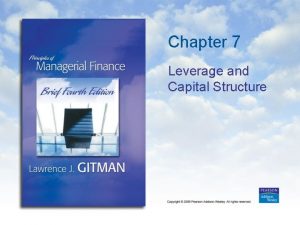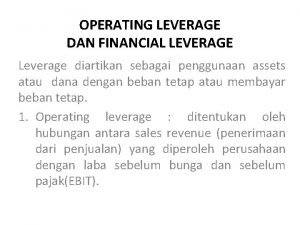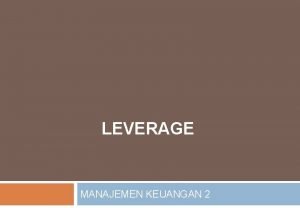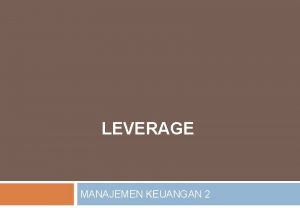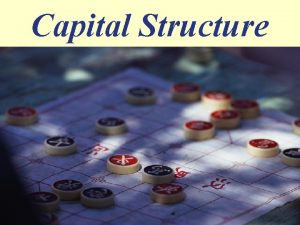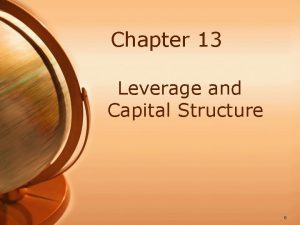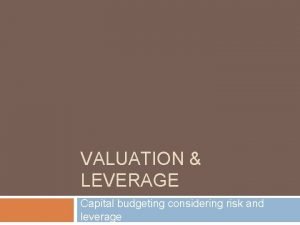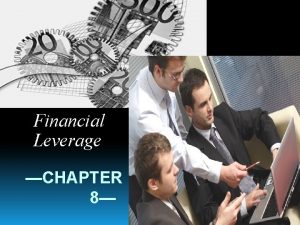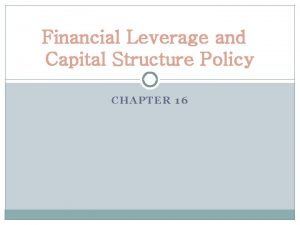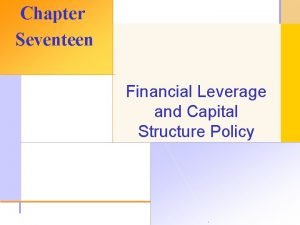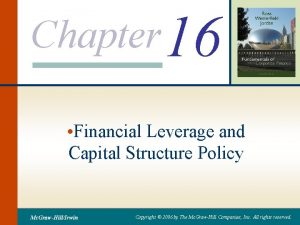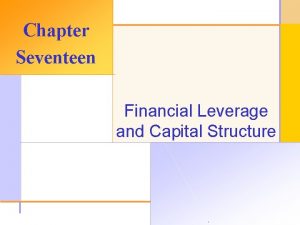CHAPTER 13 Capital Structure and Leverage n n
















- Slides: 16

CHAPTER 13 Capital Structure and Leverage n n Business vs. financial risk Optimal capital structure Operating leverage Capital structure theory 13 -1

What is business risk? n Uncertainty about future operating income (EBIT), i. e. , how well can we predict operating income? Low risk Probability High risk 0 n E(EBIT) EBIT Note that business risk does not include financing effects. 13 -2

What determines business risk? n n n Uncertainty about demand (sales). Uncertainty about output prices. Uncertainty about costs. Product, other types of liability. Operating leverage. 13 -3

What is operating leverage, and how does it affect a firm’s business risk? n n Operating leverage is the use of fixed costs rather than variable costs. If most costs are fixed, hence do not decline when demand falls, then the firm has high operating leverage. 13 -4

Effect of operating leverage n More operating leverage leads to more business risk, for then a small sales decline causes a big profit decline. Rev. $ TC $ } Profit TC FC FC QBE Sales 13 -5

What is financial leverage? Financial risk? n n Financial leverage is the use of debt and preferred stock. Financial risk is the additional risk concentrated on common stockholders as a result of financial leverage. 13 -6

Business risk vs. Financial risk n n Business risk depends on business factors such as competition, product liability, and operating leverage. Financial risk depends only on the types of securities issued. n More debt, more financial risk. 13 -7

An example: Illustrating effects of financial leverage n n Two firms with the same operating leverage, business risk, and probability distribution of EBIT. Only differ with respect to their use of debt (capital structure). Firm U No debt $20, 000 in assets 40% tax rate Firm L $10, 000 of 12% debt $20, 000 in assets 40% tax rate 13 -8

Firm U: Unleveraged Prob. EBIT Interest EBT Taxes (40%) NI Economy Bad Avg. 0. 25 0. 50 $2, 000 $3, 000 0 0 $2, 000 $3, 000 800 1, 200 $1, 800 Good 0. 25 $4, 000 0 $4, 000 1, 600 $2, 400 13 -9

Firm L: Leveraged Prob. * EBIT* Interest EBT Taxes (40%) NI Economy Bad Avg. 0. 25 0. 50 $2, 000 $3, 000 1, 200 $ 800 $1, 800 320 720 $ 480 $1, 080 Good 0. 25 $4, 000 1, 200 $2, 800 1, 120 $1, 680 *Same as for Firm U. 13 -10

Ratio comparison between leveraged and unleveraged firms FIRM U Bad Avg Good ROE TIE 6. 0% ∞ 9. 0% ∞ 12. 0% ∞ FIRM L Bad Avg Good ROE TIE 4. 8% 1. 67 x 10. 8% 2. 50 x 16. 8% 3. 30 x 13 -11

Optimal Capital Structure n n That capital structure (mix of debt, preferred, and common equity) at which P 0 is maximized. The target capital structure is the mix of debt, preferred stock, and common equity with which the firm intends to raise capital. 13 -12

Optimal Capital Structure n V= EBIT X (1 – T) WACC Where, n EBIT = Earnings before interest and taxes T = Tax rate WACC = Weighted Average Cost of Capital 13 -13

Graphical View of Optimal Capital Structure Figure: Cost Functions and Value: Capital costs and the optimal capital structure V* Value value of the firm Cost of equity Cost of Debt Annual Cost (%) WACC M* = Optimal Capital Structure Gearing Level Source: (Gitman & Hennessey, 2004)

Finding Optimal Capital Structure n The firm’s optimal capital structure can be determined two ways: n n Minimizes WACC. Maximizes EPS. 13 -15

Table for calculating WACC and determining the minimum WACC Amount D/A ratio borrowed 0. 00% $ 0 12. 50 25. 00 500 37. 50 750 50. 00 1, 000 E/A ratio ks kd (1 – T) WACC 100. 00% 12. 00% 87. 50 12. 51 4. 80 11. 55 75. 00 13. 20 5. 40 11. 25 62. 50 14. 16 6. 90 11. 44 50. 00 15. 60 8. 40 12. 00 * Amount borrowed expressed in terms of thousands of dollars 13 -16
 Chapter 13 leverage and capital structure gitman ppt
Chapter 13 leverage and capital structure gitman ppt Operating leverage formula
Operating leverage formula Financial leverage and capital structure policy
Financial leverage and capital structure policy Financial leverage and capital structure policy
Financial leverage and capital structure policy Multinational capital structure
Multinational capital structure Multinational cost of capital and capital structure
Multinational cost of capital and capital structure Operating and financial leverage chapter 5
Operating and financial leverage chapter 5 Working capital management refers to
Working capital management refers to Source of capital reserve
Source of capital reserve Difference between capital reserve and reserve capital
Difference between capital reserve and reserve capital Constant and variable capital
Constant and variable capital Business risk vs financial risk capital structure
Business risk vs financial risk capital structure Lift and leverage
Lift and leverage Chapter 14 capital structure in a perfect market
Chapter 14 capital structure in a perfect market Regulatory capital vs economic capital
Regulatory capital vs economic capital Regulatory capital vs economic capital
Regulatory capital vs economic capital Capital allocation line vs capital market line
Capital allocation line vs capital market line
